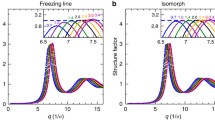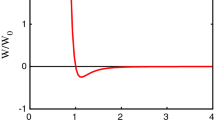Abstract
A brief review is given of transition-state theory, both for the case of unimolecular reactions in the gas phase, and for reactions in condensed phases. An argument is made that, within the context of this theory, heterogeneous freezing in Si is limited to rates much lower than collision rates by the difference between the entropies of the solid and the liquid.
Similar content being viewed by others
References
S. Glasstone, K. J. Laidler and H. Eyring, Theory of Rate Processes (McGraw-Hill, New York, 1966); and H. Eyring, S. H. Lin and S. M. Lin, Basic Chemical Kinetics (Wiley-Interscience, New York, 1980).
W. Forst, Theory of Unimolecular Reactions (Academic Press, New York, 1973).
J. W. Christian, The Theory of Transformations in Metals and Alloys, 2nd Ed. (Pergamon Press, Oxford, 1975), Chap. 3.
J. Y. Tsao, M. J. Aziz, M. O. Thompson and P. S. Peercy, Phys. Rev. Lett. 56, 2712 (1986); and manuscript submitted to Phys. Rev. B.
B. C. Larson, J. Z. Tischler and D. M. Mills, J. Mater. Res. 1, 144 (1986).
J. Y. Tsao, P. S. Peercy and M. O. Thompson, J. Mater. Res., to be published.
J. Y. Tsao, P. S. Peercy and M. O. Thompson, unpublished.
It is also possible that transition-state theory alone is inadequate, and that other theories (or combinations of theories), such as those suggested by P. H. Bucksbaum and M. O. Thompson (to be published), and by P. M. Richards (to be published), may be necessary.
This is an asymmetry additional to that which might already be present due to an activation enthalpy.
F. A. Lindemann, Trans. Faraday Soc. 17, 598 (1922).
In step 1, especially at high pressures, the strong-collision approximation (one-step activation) is usually made: a thermal population distribution is assumed to be established after each collision.
The collisional energization rate into transition states is independent of whether the system is in equilibrium or not, and so is given by the equilibrium rate (which must exactly equal the collisional de-energization rate out of the transition states (2)).
We assume that, in condensed phases under normal atmospheric pressure conditions, enthalpies are approximately equal to energies.
These two assumptions represent important differences between the ideas presented here and those of P. H. Bucksbaum and M. O. Thompson (8).
F. Spaepen and D. Turnbull, in Laser Annealing of Semiconductors, J. M. Poate and J. W. Mayer, eds. (Academic, New York, 1982), pp. 15–42.
Since and where ρS+(E) and ρ1+(E) are the densities of transition states, and kS+->1+(E) = k1+->S+(E). Note that the two sets of transition states are not the same; microscopic reversibility implies a relation governing transition rates between states, rather than equality of states.
See, e.g., Eq. (9) in K. A. Jackson, in Crystal Groth and Characterization, R. Ueda and J. B. Mullin, eds. (North-Holland, Amsterdam, 1975), pp. 21–32.
Author information
Authors and Affiliations
Rights and permissions
About this article
Cite this article
Tsao, J.Y., Aziz, M.J., Peercy, P.S. et al. Transition-State Model for Entropy-Limited Freezing. MRS Online Proceedings Library 74, 117 (1986). https://doi.org/10.1557/PROC-74-117
Published:
DOI: https://doi.org/10.1557/PROC-74-117




